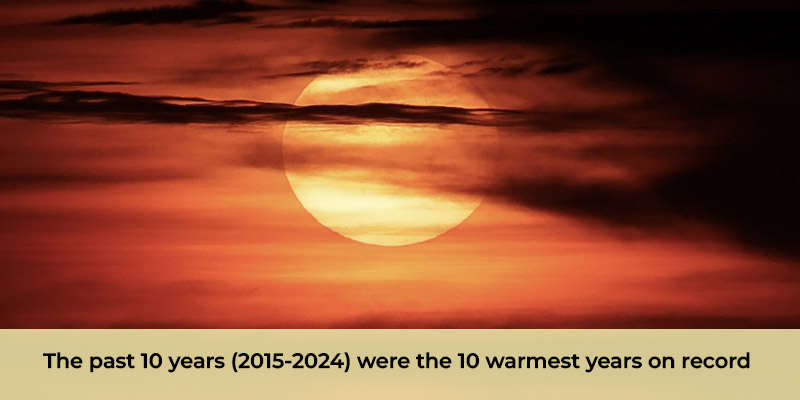- World
- Jan 11
2024 was the Earth’s warmest year on record
• Global temperatures in 2024 exceeded 1.5°C above the pre-industrial era for the first time, according to the World Meteorological Organisation (WMO).
• The global average surface temperature was 1.55°C (with a margin of uncertainty of ±0.13°C) above the 1850-1900 average, according to WMO’s consolidated analysis of the six datasets.
• The past 10 years (2015-2024) were the 10 warmest years on record.
• The WMO provides a temperature assessment based on multiple sources of data to support international climate monitoring and to provide authoritative information for the UN Climate Change negotiating process.
• The datasets are from the European Center for Medium Range Weather Forecasts (ECMWF), Japan Meteorological Agency, NASA, the US National Oceanic and Atmospheric Administration (NOAA), the UK’s Met Office in collaboration with the Climatic Research Unit at the University of East Anglia (HadCRUT), and Berkeley Earth.
• Relentless warming fuelled record-breaking heat waves, deadly storms, and floods that devastated lives and homes by the thousands in 2024.
Role of ocean warming in record high temperatures
• A separate study published in Advances in Atmospheric Sciences found that ocean warming in 2024 played a key role in the record high temperatures. The ocean is the warmest it has ever been as recorded by humans, not only at the surface but also for the upper 2000 meters, according to the study. It involved a team of 54 scientists from seven countries and 31 institutes.
• About 90 per cent of the excess heat from global warming is stored in the ocean, making ocean heat content a critical indicator of climate change.
• From 2023 to 2024, the global upper 2000 m ocean heat content increase is 16 zettajoules, about 140 times the world’s total electricity generation in 2023, according to the study.
• As global warming continues, there is an urgent need for careful tracking, monitoring and communication with regard to where the warming is relative to the long-term temperature goal of the Paris Agreement, to help policymakers in their deliberations.
What is climate change?
• Climate change is a long-term shift in weather conditions identified by changes in temperature, precipitation, winds, and other indicators. Climate change can involve both changes in average conditions and changes in variability, including, for example, extreme events.
• The Earth’s climate is naturally variable on all time scales. However, its long-term state and average temperature are regulated by the balance between incoming and outgoing energy, which determines the Earth’s energy balance.
• Any factor that causes a sustained change to the amount of incoming energy or the amount of outgoing energy can lead to climate change.
• Different factors operate on different time scales, and not all of those factors that have been responsible for changes in Earth’s climate in the distant past are relevant to contemporary climate change.
• Factors that cause climate change can be divided into two categories — those related to natural processes and those related to human activity.
• Around the world, storms, floods and wildfires are intensifying. Air pollution sadly affects the health of tens of millions of people and unpredictable weather causes untold damage to homes and livelihoods too.
• Human-caused climate change is already affecting many weather and climate extremes in every region across the globe. For example, the changing state of our glaciers has caused significant sea level rise.
• Risks and projected adverse impacts and related losses and damages from climate change escalate with every increment of global warming.
• Climatic and non-climatic risks will increasingly interact, creating compound and cascading risks that are more complex and difficult to manage. For example, increased air pollution from burning fossil fuels can worsen the impact of natural disasters like heat waves and droughts on human health.
• Constraining global warming to 1.5°C, rather than to 2°C and higher, is projected to have many benefits for terrestrial and wetland ecosystems and for the preservation of their services to humans.
What is the Paris Agreement?
• The Paris Agreement is a legally binding international treaty on climate change. It was adopted by 196 Parties at the UN Climate Change Conference (COP21) in Paris on December 12, 2015. It entered into force on November 4, 2016.
• It mobilised global collective action to pursue efforts to limit the global temperature increase to 1.5°C above pre-industrial levels by 2100, and to act to adapt to the already existing effects of climate change.
• The agreement asks countries to review commitments every five years, provide financing to developing countries to mitigate climate change, strengthen resilience and enhance abilities to adapt to climate impacts.
Manorama Yearbook app is now available on Google Play Store and iOS App Store



